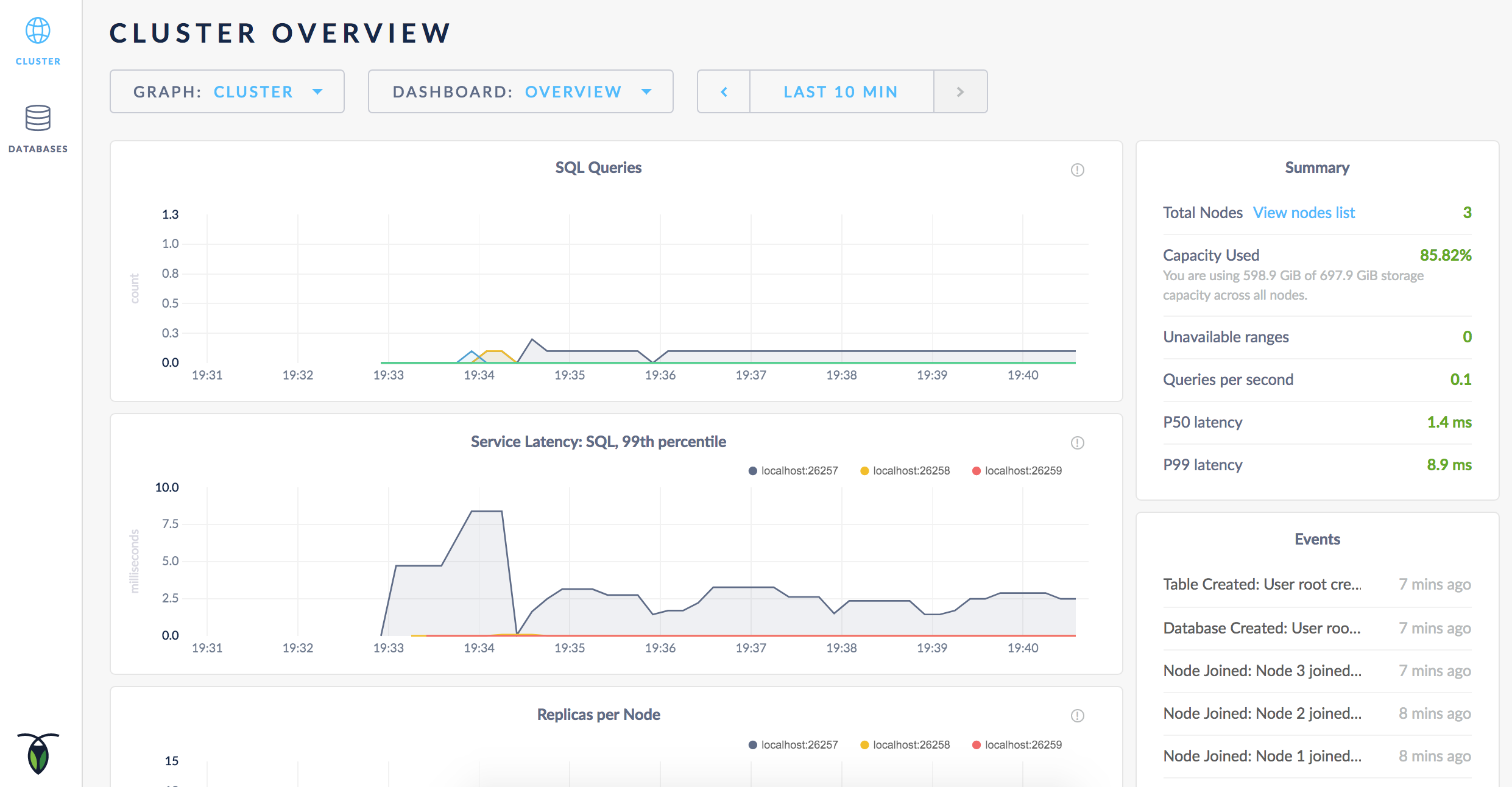
Once you’ve installed CockroachDB, it’s simple to start an insecure multi-node cluster locally.
Before You Begin
Make sure you have already installed CockroachDB.
Step 1. Start the first node
cockroach start --insecure \
--host=localhost
CockroachDB node starting at
build: CCL v1.0.7 @ 2018-02-13 00:00:00
admin: http://localhost:8080
sql: postgresql://root@localhost:26257?sslmode=disable
logs: cockroach-data/logs
store[0]: path=cockroach-data
status: initialized new cluster
clusterID: {dab8130a-d20b-4753-85ba-14d8956a294c}
nodeID: 1
This command starts a node in insecure mode, accepting most cockroach start defaults.
- The
--insecureflag makes communication unencrypted. - Since this is a purely local cluster,
--host=localhosttells the node to listens only onlocalhost, with default ports used for internal and client traffic (26257) and for HTTP requests from the Admin UI (8080). - Node data is stored in the
cockroach-datadirectory. - The standard output gives you helpful details such as the CockroachDB version, the URL for the admin UI, and the SQL URL for clients.
--cache flag in the start command.Step 2. Add nodes to the cluster
At this point, your cluster is live and operational. With just one node, you can already connect a SQL client and start building out your database. In real deployments, however, you'll always want 3 or more nodes to take advantage of CockroachDB's automatic replication, rebalancing, and fault tolerance capabilities. This step helps you simulate a real deployment locally.
In a new terminal, add the second node:
cockroach start --insecure \
--store=node2 \
--host=localhost \
--port=26258 \
--http-port=8081 \
--join=localhost:26257
In a new terminal, add the third node:
cockroach start --insecure \
--store=node3 \
--host=localhost \
--port=26259 \
--http-port=8082 \
--join=localhost:26257
The main difference in these commands is that you use the --join flag to connect the new nodes to the cluster, specifying the address and port of the first node, in this case localhost:26257. Since you're running all nodes on the same machine, you also set the --store, --port, and --http-port flags to locations and ports not used by other nodes, but in a real deployment, with each node on a different machine, the defaults would suffice.
Step 3. Test the cluster
Now that you've scaled to 3 nodes, you can use any node as a SQL gateway to the cluster. To demonstrate this, open a new terminal and connect the built-in SQL client to node 1:
cockroach binary, so nothing extra is needed.cockroach sql --insecure
Run some basic CockroachDB SQL statements:
CREATE DATABASE bank;
CREATE TABLE bank.accounts (id INT PRIMARY KEY, balance DECIMAL);
INSERT INTO bank.accounts VALUES (1, 1000.50);
SELECT * FROM bank.accounts;
+----+---------+
| id | balance |
+----+---------+
| 1 | 1000.5 |
+----+---------+
(1 row)
Exit the SQL shell on node 1:
\q
Then connect the SQL shell to node 2, this time specifying the node's non-default port:
cockroach sql --insecure --port=26258
26257, and so you wouldn't need to set the --port flag.Now run the same SELECT query:
SELECT * FROM bank.accounts;
+----+---------+
| id | balance |
+----+---------+
| 1 | 1000.5 |
+----+---------+
(1 row)
As you can see, node 1 and node 2 behaved identically as SQL gateways.
Exit the SQL shell on node 2:
\q
Step 4. Monitor the cluster
To access the Admin UI for your cluster, point a browser to http://localhost:8080, or to the address in the admin field in the standard output of any node on startup:

As mentioned earlier, CockroachDB automatically replicates your data behind-the-scenes. To verify that data written in the previous step was replicated successfully, scroll down to the Replicas per Node graph and hover over the line:

The replica count on each node is identical, indicating that all data in the cluster was replicated 3 times (the default).
Step 5. Stop the cluster
Once you're done with your test cluster, switch to the terminal running the first node and press CTRL-C to stop the node.
At this point, with 2 nodes still online, the cluster remains operational because a majority of replicas are available. To verify that the cluster has tolerated this "failure", connect the built-in SQL shell to nodes 2 or 3. You can do this in the same terminal or in a new terminal.
cockroach sql --insecure --port=26258
SELECT * FROM bank.accounts;
+----+---------+
| id | balance |
+----+---------+
| 1 | 1000.5 |
+----+---------+
(1 row)
Exit the SQL shell:
\q
Now stop nodes 2 and 3 by switching to their terminals and pressing CTRL-C.
If you do not plan to restart the cluster, you may want to remove the nodes' data stores:
rm -rf cockroach-data node2 node3
Step 6. Restart the cluster
If you decide to use the cluster for further testing, you'll need to restart at least 2 of your 3 nodes from the directories containing the nodes' data stores.
Restart the first node from the parent directory of cockroach-data/:
cockroach start --insecure \
--host=localhost
In a new terminal, restart the second node from the parent directory of node2/:
cockroach start --insecure \
--store=node2 \
--host=localhost \
--port=26258 \
--http-port=8081 \
--join=localhost:26257
In a new terminal, restart the third node from the parent directory of node3/:
cockroach start --insecure \
--store=node3 \
--host=localhost \
--port=26259 \
--http-port=8082 \
--join=localhost:26257
What's Next?
- Learn more about CockroachDB SQL and the built-in SQL client
- Install the client driver for your preferred language
- Build an app with CockroachDB
- Explore core CockroachDB features like automatic replication, rebalancing, fault tolerance, and cloud migration.